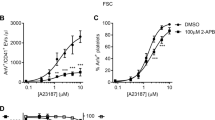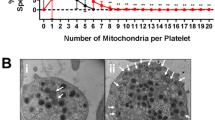Abstract
Activation of caspases has been demonstrated to be involved in thrombocytopenia and prolonged storage of platelet concentrates. Platelets represent enucleate cells that comprise all elements of the mitochondrial apoptosis pathway. However, no apoptotic stimuli capable of activating the endogenous caspase cascade have been identified so far. Using tributyltin (TBT) we could identify a compound that is capable of activating caspase-9 and -3 in platelets. Recent studies implicate that TBT induces apoptosis via the mitochondrial signaling pathway that is characterized by the formation of a high-molecular-weight complex (apoptosome) containing the adapter protein Apaf-1 and active caspase-9. Interestingly, addition of TBT induced the activation of caspase-9 in an ultra-rapid kinetic within the first 2 min. In addition, size exclusion chromatography revealed that TBT-mediated processing of caspase-9 occurs in the absence of the apoptosome. Thus, these data implicate that TBT induces the activation of caspase-9 by a mechanism not involving the formation of the apoptosome.
This is a preview of subscription content, access via your institution
Access options
Subscribe to this journal
Receive 50 print issues and online access
$259.00 per year
only $5.18 per issue
Buy this article
- Purchase on Springer Link
- Instant access to full article PDF
Prices may be subject to local taxes which are calculated during checkout


Similar content being viewed by others
References
Aw TY, Nicotera P, Manzo L and Orrenius S . (1990). Arch. Biochem. Biophys., 283, 46–50.
Bantel H, Engels I, Voelter W, Schulze-Osthoff K and Wesselborg S . (1999). Cancer Res., 59, 2083–2090.
Belka C, Rudner J, Wesselborg S, Stepczynska A, Marini P, Lepple-Wienhues A, Faltin H, Bamberg M, Budach W and Schulze-Osthoff K . (2000). Oncogene, 19, 1181–1190.
Berg CP, Engels IH, Rothbart A, Lauber K, Renz A, Schlosser SF, Schulze-Osthoff K and Wesselborg S . (2001). Cell Death Differ., 8, 1197–1206.
Bratosin D, Estaquier J, Petit F, Arnoult D, Quatannens B, Tissier JP, Slomianny C, Sartiaux C, Alonso C, Huart JJ, Montreuil J and Ameisen JC . (2001). Cell Death Differ., 8, 1143–1156.
Cain K, Hyams RL and Griffiths DE . (1977). FEBS Lett., 82, 23–28.
Cardone MH, Roy N, Stennicke HR, Salvesen GS, Franke TF, Stanbridge E, Frisch S and Reed JC . (1998). Science, 282, 1318–1321.
Chow SC, Kass GE, McCabe Jr MJ and Orrenius S . (1992). Arch. Biochem. Biophys., 298, 143–149.
De Botton S, Sabri S, Daugas E, Zermati Y, Guidotti JE, Hermine O, Kroemer G, Vainchenker W and Debili N . (2002). Blood, 100, 1310–1317.
Engels IH, Stepczynska A, Stroh C, Lauber K, Berg C, Schwenzer R, Wajant H, Jänicke RU, Porter AG, Belka C, Gregor M, Schulze-Osthoff K and Wesselborg S . (2000). Oncogene, 19, 4563–4573.
Ferrari D, Stepczynska A, Los M, Wesselborg S and Schulze-Osthoff K . (1998). J. Exp. Med., 188, 979–984.
Harris EL, Bangham JA and Zukovic B . (1973). FEBS Lett., 29, 339–344.
Jacobsen MD, Weil M and Raff MC . (1996). J. Cell Biol., 133, 1041–1051.
Lauber K, Appel HA, Schlosser SF, Gregor M, Schulze-Osthoff K and Wesselborg S . (2001). J. Biol. Chem., 276, 29772–29781.
Leist M and Jäättelä M . (2001). Cell Death Differ., 8, 324–326.
Li J, Xia Y, Bertino AM, Coburn JP and Kuter DJ . (2000). Blood, 40, 1320–1329.
Los M, Wesselborg S and Schulze-Osthoff K . (1999). Immunity, 10, 629–639.
Marsden VS, O’Connor L, O’Reilly LA, Silke J, Metcalf D, Ekert PG, Huang DC, Cecconi F, Kuida K, Tomaselli KJ, Roy S, Nicholson DW, Vaux DL, Bouillet P, Adams JM and Strasser A . (2002). Nature, 419, 634–637.
Nakagawa T, Hong Zhu H, Nobuhiro Morishima N, Li E, Xu J, Yankner BA and Junying Yuan J . (2000). Nature, 403, 98–103.
Nishikimi A, Kira Y, Kasahara E, Sato EF, Kanno T, Utsumi K and Inoue M . (2001). Biochem. J., 356, 621–626.
Nopp A, Lundahl J and Stridh H . (2002). Clin. Exp. Immunol., 128, 267–274.
Piguet PF, Kan CD and Vesin C . (2002). Apoptosis, 7, 91–98.
Plenchette S, Moutet M, Benguella M, N’Gondara JP, Guigner F, Coffe C, Corcos L, Bettaieb A and Solary E . (2001). Leukemia, 15, 1572–1581.
Powers MF and Beavis AD . (1991). J. Biol. Chem., 266, 17250–17256.
Raffray M and Cohen GM . (1993). Arch. Toxicol., 67, 231–236.
Rao RV, Castro-Obregon S, Frankowski H, Schuler M, Stoka V, del Rio G, Bredesen DE and Ellerby HM . (2002). J. Biol. Chem., 277, 21836–21842.
Robertson JD, Gogvadze V, Zhivotovsky B and Orrenius S . (2000). J. Biol. Chem., 275, 32438–32443.
Schulze-Osthoff K, Ferrari D, Los M, Wesselborg S and Peter ME . (1998). Eur. J. Biochem., 254, 439–459.
Schulze-Osthoff K, Walczak H, Dröge W and Krammer PH . (1994). J. Cell Biol., 127, 15–20.
Seinen W, Vos JG, van Krieken R, Penninks A, Brands R and Hooykaas H . (1977). Toxicol. Appl. Pharmacol., 42, 213–224.
Shcherbina A and Remold O’Donnell E . (1999). Blood, 93, 4222–4231.
Snoeij NJ, Penninks AH and Seinen W . (1988). Int. J. Immunopharmacol., 10, 891–899.
Stepczynska A, Lauber K, Engels IH, Janssen O, Kabelitz D, Wesselborg S and Schulze-Osthoff K . (2001). Oncogene, 20, 1193–1202.
Stridh H, Fava E, Single B, Nicotera P, Orrenius S and Leist M . (1999a). Chem. Res. Toxicol., 12, 874–882.
Stridh H, Gigliotti D, Orrenius S and Cotgreave I . (1999b). Biochem. Biophys. Res. Commun., 266, 460–465.
Stridh H, Kimland M, Jones DP, Orrenius S and Hampton MB . (1998). FEBS Lett., 429, 351–355.
Vanags DM, Orrenius S and Aguilar Santelises M . (1997). Br. J. Haematol., 99, 824–831.
Vos JG, de Klerk A, Krajnc El, Kruizinga W, van Ommen B and Rozing J . (1984). Toxicol. Appl. Pharmacol., 75, 387–408.
Vos JG, De Klerk A, Krajnc EI, Van Loveren H and Rozing J . (1990). Toxicol. Appl. Pharmacol., 105, 144–155.
Wesselborg S, Engels IH, Rossmann E, Los M and Schulze-Osthoff K . (1999). Blood, 93, 3053–3063.
Wolf BB, Goldstein JC, Stennicke HR, Beere H, Amarante-Mendes GP, Salvesen GS and Green DR . (1999). Blood, 94, 1683–1692.
Acknowledgements
We thank Dr Y Lazebnik for providing mAb against caspase-9. This work was supported by grants from the Federal Ministry of Education, Science, Research and Technology (Fö. 01KS9602), and the Interdisciplinary Center of Clinical Research Tübingen (IZKF) and from the Deutsche Forschungsgemeinschaft (WE-1801/1). C Berg acknowledges a fellowship from the Fortune Program of the University of Tübingen.
Author information
Authors and Affiliations
Corresponding author
Rights and permissions
About this article
Cite this article
Berg, C., Rothbart, A., Lauber, K. et al. Tributyltin (TBT) induces ultra-rapid caspase activation independent of apoptosome formation in human platelets. Oncogene 22, 775–780 (2003). https://doi.org/10.1038/sj.onc.1206221
Received:
Revised:
Accepted:
Published:
Issue Date:
DOI: https://doi.org/10.1038/sj.onc.1206221



